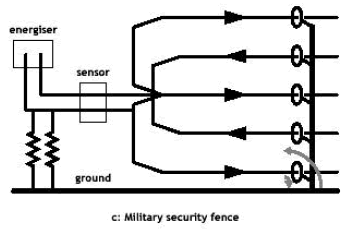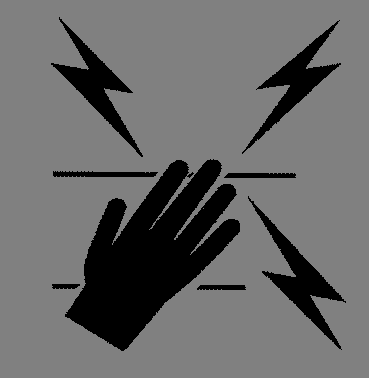Electrified security fences
OM 2011/04
Author Unit/Section:? Safety Unit
Target Audience: All Inspectors
Summary
This OM alerts inspectors to the use of electrified fences designed to deter the entry of unauthorised persons into premises, storage compounds and other areas. It provides information on the standards required for the design and installation of the fences.
Introduction
Electrified stock control fences have been in use in this country for many years and generally consist of one or more rigidly mounted strand(s) of wire together with an energiser and control box.
Figure 1

Typically, all of the fence strands are connected together and the return shock current path is through the ground. Since the output of the fence energiser is pulsed, conventional measurements of voltage and current would be difficult to interpret. As a result, the output is defined as the energy in each pulse measured in joules, where one joule is one watt of power applied for one second. Standards have been developed relating to the maximum acceptable output energy level of the pulses transmitted along the wire, typically 5 joules, 8 joules, or greater than 8 joules.


Recently, electrified fences have been developed which are designed to deter unauthorised persons from entering premises such as car storage compounds, builders merchants, factory yards, unattended electricity substations, etc. The first known of these was installed in the UK in 1992 and the number of installations is expected to increase rapidly as they have, so far, proved to be a very effective deterrent.
Action
Action by inspectors
Inspectors can, if necessary, ask for information to establish whether electrified security fences meet the standards referred to later in this document.
Brief information relating to installations that are not manufactured or installed by one of the supplying companies (see Appendix 1) or their agents , particularly if they do not meet appropriate standards, should be sent to the Product Safety Team and Safety Unit should be informed.
Where installations result in significant risk, either as a result of the energiser exceeding 5 joules, or as a result of the design or installation of the fence creating mantraps, appropriate enforcement action may be necessary. Under such circumstances specialist groups should be consulted at an early stage. When enforcement action is taken Safety Unit should be informed
Background
Design and installation
The fences consist of several horizontally mounted parallel strands of spring steel wire, each approximately 100 mm apart, which can be located on top of, or inside of, an existing or new wall or fence.
Figure 2


Each wire runs through plastic insulator bushes mounted on fence posts that are a maximum of 3 m apart. The wires are tensioned so that under normal weather/wind conditions they do not sag and touch, however they can be easily moved by hand, and would sag and short out to each other if used as footholds by a climber.
Figure 3 - How an electrified security system is configured

("Figure 3 is reproduced by permission of Gallagher Security (UK) Ltd")
The insulator bushes are designed to shear off if a climber attempts to scale the fence. However, they would take the weight of a child.
Alternate strands of the fence are connected together and the main shock current return path is intended to be the adjacent fence strand (see Figure 1 ). To receive a shock it may be necessary to touch two or more strands of wire simultaneously, or in some cases, to touch one wire and the ground as with an agricultural stock control type fence. The shock itself is unpleasant but should not cause harm.
Each fence has an energiser and control box. Unlike stock control fences, the security fences are continuously monitored when energised and are designed to activate an alarm system, either on site or elsewhere, to alert someone to the fact that intruders have tried to gain access or cut the wires.
A number of companies supply these types of fence, the components of which will have been selected and manufactured to an acceptable standard. Detailed instructions should be provided covering their installation to ensure their safety.
Risks
The main risks are of an unpleasant electric shock due to contact with the fence, falls and falls from a height after coming into contact with a fence projecting beyond the top of a wall etc. There is also a remote possibility of death due to exhaustion if a person became trapped across or against a fence and could not easily free themselves. In the UK it is known that at least one person has been rendered unconscious due to repeated shocks where the clearances (see Precautions) were infringed. There has also been one reportable accident involving a homemade "fence" energised by direct connection to the mains supply.
There have been deaths involving animals as a direct result of contact with agricultural stock control electric fences.
Precautions
Design and installation standards for electrified security fences at commercial premises should meet the following minimum standards which have been discussed and agreed by the HSE Specialist Inspectors (Electrical Engineering), and Safety Unit:
- The energiser output should be limited to 5 joules as per BS EN 60335-2-76: 2005 Household and similar electrical appliances. Safety. Particular requirements for electric fence energisers. N.B. equipment designed in accordance with the earlier Standards BS EN 60334-2-76: 1999 and BS EN 61011 1993 may still be in use
- The fence should be designed to avoid a person becoming caught over or against it and unable to remove themselves (mantraps). This is done by design and spacing of fence components - Figure 2 shows fence designs that avoid mantraps. The gap between the security fence and the outer fence should be either less than 200mm or more than 1000mm NOTE: Barbed wire or razor wire must not be used as part of or adjacent to the fences (see below)
- The outer non-electrified barrier or fence should have a minimum height of 1.8 metres
- Where the outer barrier has openings in it, then all openings in that barrier should comply with Table 4 of BS EN ISO13857:2008 (Safety of Machinery - Safety distances to prevent hazard zones being reached by the upper and lower limbs). Also, where children may be present, Table 5 of the same standard in order to prevent contact with the electrified fence at ground level
- The outer barrier should be sufficiently robust and rigid to prevent infringement of the requirements of paragraphs stated above
- Where it is necessary to angle the top of the fence (see figure 2) it should face where possible to the outside. Where this is not possible then sufficient clearance should be provided with a minimum height of 2 metres above ground level to the base of that angle
- Where the security fence is energised during working hours, then there should be an inner barrier with dimensions as in Figure 2. If the distance is less than 200 mm then the inner barrier should comply with the requirements above. If the clearance is 1000 mm or more then this clearance distance should be delineated preferably by a kerb or similar and there should be no walkway within the 1000 mm clearance distance
- The fence design should ensure that when two adjacent strands are connected together the shock risk is reduced, if not removed. This may be achieved by connecting the energiser output terminals to alternate strands of the fence. If any two adjacent strands then connect together, they will then cause the shock current to flow from one strand back through the other strand, in preference to flowing through the body of the person making contact with the fence
- Warning signs should be prominently displayed on all security fences at spacings not exceeding 10 m. They should face to the outside and where access may be gained from the inside on that side also. The mounting heights above ground level should be at 1.5 m whilst if there may be children present there should be a repeater sign at 0.8 m
- The size of the warning sign should be at least 200 mm x 100 mm and shall be coloured yellow. The inscription should be indelible and take the form of the following symbol:

- The security fence should not be supplied from more than one energiser or from independent circuits of the same energiser. If there are separate security fences then unless they are supplied from the same circuit of the energiser the fences should be separated by a distance of at least 2 m
- If the external barrier is a metal fence and the security fence is supported from that fence then the impedance to earth of the support fence should not exceed 10 ohms. Should this value not be achieved then an earth mat should be provided to satisfy those requirements. For electrical generating stations and substations BS 7430: 2011 Code of practice for protective earthing of electrical installations should be consulted
- The installation of connecting leads and security fence wires in the proximity of overhead lines should comply with the requirements of Annex BB of BS EN 60335-2-76:2005 (as amended)
- If the high voltage output of the fence energiser requires to be earthed then the energiser electrode shall penetrate the ground to at least 1 m and the electrode should be located at least 10 m from any other electrical earth including electrical power, lightning protection and earths provided for the protection of electronic or telecommunication equipment
- Electrical conductors from the fence energiser should be insulated for the voltage of that energiser and installed in dedicated trunking or conduit; The low voltage supply to the fence energiser should be installed in accordance with BS 7671:2008 (as amended)
- It is important that the installations are not subsequently modified by users in a manner that would not comply with the above. For example, the subsequent installation of barbed or razor wire or of additional fencing close to the security fence. Both of these could result in the creation of 'mantraps', ie people could be caught against the fence strands and be unable to easily release themselves and find purchase for their hands and feet in order to get off the fence. This could eventually result in exhaustion and then death
Further references
Electrified Security Fence manufacturers
Current manufacturers are:
- Advance Perimeter Systems Ltd
- Gallagher Security Europe Ltd
- Harper Chalice Group Ltd
- Rutland Electric Fencing Company Ltd
There are several suppliers of electrified security fences most of these organisations install fences under license to the above four companies.
Contacts
Safety Unit